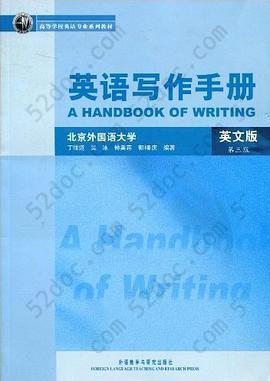注重体验与质量的电子书资源下载网站
分类于: 人工智能 设计
简介

英语写作手册: (英文版·第3版) 豆 8.4分
资源最后更新于 2020-08-26 06:29:42
作者:丁往道
出版社:外语教学与研究出版社
出版日期:2009-01
ISBN:9787560087863
文件格式: pdf
标签: 英语 写作 英语写作手册 教材 英语写作 英语学习 writing 考研
简介· · · · · ·
《英语写作手册(英文版)第3版》旨在为非英语专业的学生提供一些实用的英文写作技巧。全书分十章,对文体格式,遣词造句、整篇作文,论文和书信,简历等的写作都做了详尽的阐述。它既用中文讲解,又保留了英语例句和范文,从而会使读者受益匪浅;这样的写作训练是全面的训练,不仅有助于提高语言水平,还有助于提高观察分析、逻辑思考的能力,有助于培养严谨的工作作风,这无疑对我国的英语教学工作是一大推进。
目录
Pnrt One Manuscript Form
Ⅰ.Arrangement
Ⅱ. Capitalization
III. Word Division
Ⅳ. Punctuation
Ⅴ.Handwriting
Part Two Diction
Ⅰ.Levels of Words
Ⅱ. The Meaning of Words
Ⅲ. General and Specific Words
Ⅳ. Idioms
Ⅴ.Figures of Speech
1. Simile
2. Metaphor
3. Personification
4. Metonymy
5. Synecdoche
6. Euphemism
7. Irony
8. Overstatement and Understatement
9. Transferred Epithet
10. Oxymoron
11. Alliteration
Ⅵ. Dictionaries
1. Using Dictionaries
2. Some Good Dictionaries
Part Three The Sentence
Ⅰ.Complete Sentences and Sentence Fragments
Ⅱ. Types of Sentences
1. Declarative, Interrogative, Imperative, and Exclamatory Sentences
2. Simple, Compound, Complex, and Compound-Complex Sentences
3. Loose, Periodic, and Balanced Sentences
4. Short and Long Sentences
Ⅲ. Effective Sentences
1. Unity
2. Coherence
3. Conciseness
4. Emphasis
5. Variety
Part Four The Paragraph
Ⅰ.Criteria of an Effective Paragraph
1. Unity
2. Coherence
3. Transition
Ⅱ. Steps in Writing a Paragraph
Ⅲ. Ways of Developing Paragraphs
1. Development by Time
2. Development by Process
3. Development by Space
4. Development by Example or Generalization
5. Development by Comparison and Contrast
6. Development by Cause and Effect
7. Development by Classification
8. Development by Definition
9. Development by a Combination of Methods
Par Five The Whole Composition
Ⅰ.Criteria of a Good Composition
Ⅱ. Steps in Writing a Composition
1. Planning a Composition
2. Writing the First Draft
3. Revising the First Draft
4. Making the Final Copy
Ⅲ. Three Main Parts of a Composition
1. The Beginning
2. The Middle
3. The End
Ⅳ. Types of Writing
1. Description
2. Narration
3. Exposition
4. Argumentation
Part Six The Summary and Book Report
Part Seven Formal and Informal Styles
Part Eight The Research Paper
Part Nine Practical Writing
Part ten Punctuation
批改/校对符号
写作错误统计表
Ⅰ.Arrangement
Ⅱ. Capitalization
III. Word Division
Ⅳ. Punctuation
Ⅴ.Handwriting
Part Two Diction
Ⅰ.Levels of Words
Ⅱ. The Meaning of Words
Ⅲ. General and Specific Words
Ⅳ. Idioms
Ⅴ.Figures of Speech
1. Simile
2. Metaphor
3. Personification
4. Metonymy
5. Synecdoche
6. Euphemism
7. Irony
8. Overstatement and Understatement
9. Transferred Epithet
10. Oxymoron
11. Alliteration
Ⅵ. Dictionaries
1. Using Dictionaries
2. Some Good Dictionaries
Part Three The Sentence
Ⅰ.Complete Sentences and Sentence Fragments
Ⅱ. Types of Sentences
1. Declarative, Interrogative, Imperative, and Exclamatory Sentences
2. Simple, Compound, Complex, and Compound-Complex Sentences
3. Loose, Periodic, and Balanced Sentences
4. Short and Long Sentences
Ⅲ. Effective Sentences
1. Unity
2. Coherence
3. Conciseness
4. Emphasis
5. Variety
Part Four The Paragraph
Ⅰ.Criteria of an Effective Paragraph
1. Unity
2. Coherence
3. Transition
Ⅱ. Steps in Writing a Paragraph
Ⅲ. Ways of Developing Paragraphs
1. Development by Time
2. Development by Process
3. Development by Space
4. Development by Example or Generalization
5. Development by Comparison and Contrast
6. Development by Cause and Effect
7. Development by Classification
8. Development by Definition
9. Development by a Combination of Methods
Par Five The Whole Composition
Ⅰ.Criteria of a Good Composition
Ⅱ. Steps in Writing a Composition
1. Planning a Composition
2. Writing the First Draft
3. Revising the First Draft
4. Making the Final Copy
Ⅲ. Three Main Parts of a Composition
1. The Beginning
2. The Middle
3. The End
Ⅳ. Types of Writing
1. Description
2. Narration
3. Exposition
4. Argumentation
Part Six The Summary and Book Report
Part Seven Formal and Informal Styles
Part Eight The Research Paper
Part Nine Practical Writing
Part ten Punctuation
批改/校对符号
写作错误统计表








